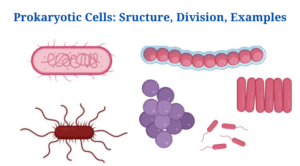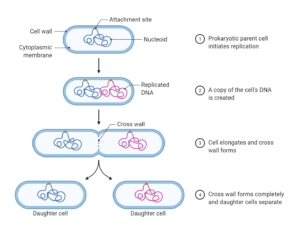Prokaryotic Cells Definition
Prokaryotic cells are single-celled organisms that lack a membrane-bound nucleus and other organelles, making them primitive in form and function. The name “prokaryote” comes from two Greek words: “pro” for “before” and “karyon” for “nucleus.” Prokaryotes, the simplest form of life, are thought to be the first living species on the planet.
Prokaryotic cell characteristics
The following are the general properties of prokaryotic cells:
- Prokaryotic cells are significantly smaller than eukaryotic cells, ranging in size from 0.1 to 5.0 m.
- Prokaryotic cells come in a variety of shapes, including cocci, bacilli, spirilla, and vibrio. In nature, however, prokaryotic cells with variations of these morphologies can be discovered.
- Because prokaryotic cells lack a membrane-bound nucleus and other membrane-bound cell organelles, their cellular structure is rudimentary.
- A single strand of DNA makes up the genetic material of prokaryotic cells in a single chromosome.
- In prokaryotic cells, a key protein called histone protein, which is found bound in the chromosomes of eukaryotes, is missing.
- The nucleolus and the mitotic machinery are also absent in prokaryotic cells.
- Prokaryotic cells have a non-cellulosic cell wall made up of carbohydrates and lipids.
- Because prokaryotic cells are asexual, they reproduce without the creation of gametes.
Image Created with BioRender.com
Prokaryotic cells Structure (Components/Parts)
Since prokaryotic cells have rudimentary cell organelles, their structure is less sophisticated than that of eukaryotic cells. The following components/parts are found in most prokaryotic cells:
- Capsule
- Some prokaryotic cells have an extra outer layer that serves to shield them from foreign invaders.
- Polysaccharides make up the capsule, which helps the cells to attach to diverse surfaces while keeping the moisture in the cell.
- Cell wall
- Inside the capsule, the cell wall is a strong coring of bacterial cells.
- Peptidoglycan is a polymer of carbohydrates and lipids that makes up the cell wall of most prokaryotes.
- The cell wall of Archaeal cells, on the other hand, does not contain peptidoglycan but rather a different substance known as pseudopeptidoglycan. Proteins and other polymers make up this substance.
- The cell wall gives the cell its structure while also safeguarding the cell organelles in the cytoplasm.
- Cell membrane/ Cytoplasmic membrane/ Plasma membrane
- A phospholipid-based cell membrane is found beneath the cell wall.
- The phospholipid is made up of two hydrophilic fatty acid tails and a lipid made up of glycerol coupled to a hydrophobic phosphate head.
- The phospholipid tails are frequently linked in archaea, forming a monolayer rather than a bilayer structure.
- In prokaryotic cells, the plasma membrane defends the cell while simultaneously allowing essential chemicals to enter and depart.
- Cytoplasm
- The cytoplasm is the total region within the cell membrane that is occupied by cells.
- It has a gel-like cytosol and a water-based solution with minerals and other ions that the cell needs.
- Other cellular structures, such as chromosomes and ribosomes, are also found in the cytoplasm.
- Ribosomes
- 70S ribosomes are found in all bacterial cells. The 30S and 50S subunits of the 70S ribosome are made up of two subunits.
- 16S rRNA is found in the 30S subunit, while 23S and 5S rRNA are found in the 50S subunit.
- In prokaryotic cells, the ribosome is the most visible internal structure.
- Varied prokaryotic cells have different ribosome sizes and numbers.
- The ribosome is in charge of forming polypeptides and, as a result, proteins.
6.Nucleoid region
- In prokaryotic cells, the nucleoid area of the cytoplasm contains a single circular chromosome and tiny rings of extrachromosomal DNA known as plasmids.
- In contrast to eukaryotes, which have two copies of DNA, the single circular chromosome is present as a single copy of genetic information.
- The genomes of prokaryotes are also smaller than those of eukaryotes.
- The plasmids, in turn, are copied outside of the chromosomes on their own. Some non-essential genes could be carried by these plasmids.
How to increase Brain Power – Secrets of Brain Unlocked
7. Appendages
- Flagella, pili, and fimbriae are examples of bacterial cell appendages that protrude from the cell surface.
- Many prokaryotic cells have flagella as their most common appendage.
- These structures resemble tails and help the cell move about.
- Fimbriae are tiny filamentous features that help cells adhere to different surfaces.
- Pilli, on the other hand, are longer filaments that serve a variety of functions in different cells. The sex pilli, which binds two cells together while they transfer DNA molecules via conjugation, is an example of this.
Prokaryotic cell Division (Reproduction)
Prokaryotic cells proliferate asexually, without the creation of gametes, as previously stated. In prokaryotes, there are several asexual ways of reproduction:
(A) Binary fission
- Binary fission is an asexual reproduction method in which a single living cell or organelle doubles in size before splitting into two identical daughter cells, each of which has the potential to expand to the size of the original cell or organelle.
- In many prokaryotes, such as archaea, cyanobacteria, and eubacteria, binary fission is the way of reproduction.
- The genetic material of the parent cell is evenly divided into two daughter cells during this procedure. As a result, the freshly generated prokaryotic cells show no genetic variation.
Figure: Prokaryotic cell Division Binary fission image Created with BioRender.com
Binary fission’s steps
- The cell’s DNA splits into two identical DNA molecules, which are both pushed towards the cell membrane.
- The cell then doubles in size, and the cell membrane divides gently, each bearing a copy of the DNA.
- The cell wall is created between the two strands of DNA after the cell membrane has been divided, splitting the parent cell into two identical daughter cells.
(1) Recombination
- Recombination is another asexual mechanism of reproduction in bacterial organisms.
- Transduction, transformation, and conjugation are used to insert the genetic material of one cell into the cell of another prokaryote.
- Two cells are joined via sex pilli in conjugation, and genes are passed through the pilli.
- The prokaryotic cell absorbs genetic material from the environment and incorporates it into the bacterial chromosome during transformation.
- The exchange of genes occurs during transduction when a virus infects a cell. The bacteriophage infects one bacterium before stealing the desired gene and transferring it to another.
Examples of Prokaryotic Cells
(a) Cells of bacteria
- Bacteria are single-celled organisms that can be found in every habitat on the planet.
- The bacterial cell wall is made up of peptidoglycan, which makes it robust and thick.
- Capsules are only found in certain bacteria and may not be found in other prokaryotic cells.
- Bacterial genetic material is found in the form of circular chromosome coils.
- coli, Streptomyces spp, Pseudomonas spp, and other bacteria are examples of bacterial cells.
(b) Cell of an Archaeon (Archaea)
- As primitive unicellular creatures, archaeal cells are comparable to bacterial cells.
- Archaeal cells can be found in a variety of severe habitats, including hot springs, oceans, and marshes.
- In archaeal cells, the capsule is absent, and the cell wall is made up of pseudopeptidoglycan, a protein-based material.
- Similarly, archaeal cells have a phospholipid monolayer on their cell membrane that shields them against severe conditions.
- Archaeal cells include Halobacterium spp., Thermoplasma spp., Sulfolobus spp., and others.
Frequently Asked Questions / Answers to Revision Questions
What are three prokaryotic cell examples?
Blue-green algae, E. coli, and mycoplasma are all examples of prokaryotic cells.
Do ribosomes exist in prokaryotic cells?
Ribosomes do exist in bacterial cells. The ribosome is a type 70S ribosome.
Is there a nucleus in prokaryotic cells?
Although prokaryotic cells lack a membrane-bound nucleus, they do have a nucleoid area in the cytoplasm that houses the genetic material.
Are mitochondria found in prokaryotic cells?
Mitochondria do not exist in prokaryotic cells.
Is it true that DNA can be discovered in prokaryotic cells?
Yes, DNA is found in prokaryotic cells as genetic material and extrachromosomal plastids.
What is the process by which prokaryotic cells divide?
Asexual techniques such as binary fission and conjugation are used by prokaryotic cells to divide.
Click Here for Complete Biology Notes
Prokaryotic Cells Citations
- https://www.khanacademy.org/science/biology/bacteria-archaea/prokaryote-structure/a/prokaryote-structure
- https://www.bartleby.com/solution-answer/chapter-1-problem-16re-biochemistry-9th-edition/9781305961135/recall-list-five-differences-between-prokaryotes-and-eukaryotes/dbf2911a-5519-11e9-8385-02ee952b546e
- https://quizlet.com/44080662/biology-ch11-flash-cards/
- https://biologydictionary.net/prokaryotic-cell/
- https://www.thoughtco.com/prokaryotes-meaning-373369
- https://owlcation.com/stem/What-Are-Cells-Made-Of-Prokaryotic-Cell-Structure-Part-3-of-3
- https://en.wikipedia.org/wiki/Cell_envelope
- https://en.wikipedia.org/wiki/Binary_fission
- https://en.wikipedia.org/wiki/Bacterial_cell_structure
- https://courses.lumenlearning.com/boundless-biology/chapter/prokaryotic-cells/
- https://www.thoughtco.com/bacterial-reproduction-373273
- https://www.ncbi.nlm.nih.gov/books/NBK7908/
- https://www.khanacademy.org/science/biology/structure-of-a-cell/prokaryotic-and-eukaryotic-cells/a/plasma-membrane-and-cytoplasm
- https://www.dummies.com/education/science/biology/the-outer-membrane-of-prokaryotic-cells/
- https://www.britannica.com/science/prokaryote
Related Posts
- Phylum Porifera: Classification, Characteristics, Examples
- Dissecting Microscope (Stereo Microscope) Definition, Principle, Uses, Parts
- Epithelial Tissue Vs Connective Tissue: Definition, 16+ Differences, Examples
- 29+ Differences Between Arteries and Veins
- 31+ Differences Between DNA and RNA (DNA vs RNA)
- Eukaryotic Cells: Definition, Parts, Structure, Examples
- Centrifugal Force: Definition, Principle, Formula, Examples
- Asexual Vs Sexual Reproduction: Overview, 18+ Differences, Examples
- Glandular Epithelium: Location, Structure, Functions, Examples
- 25+ Differences between Invertebrates and Vertebrates
- Lineweaver–Burk Plot
- Cilia and Flagella: Definition, Structure, Functions and Diagram
- P-value: Definition, Formula, Table and Calculation
- Nucleosome Model of Chromosome
- Northern Blot: Overview, Principle, Procedure and Results


















